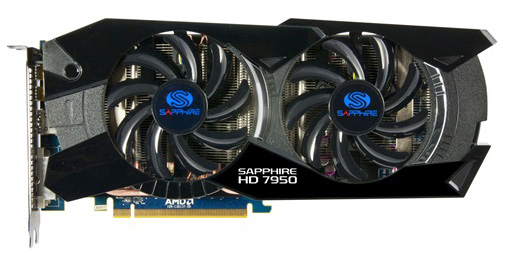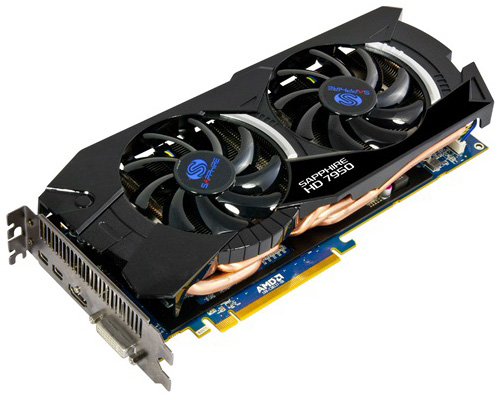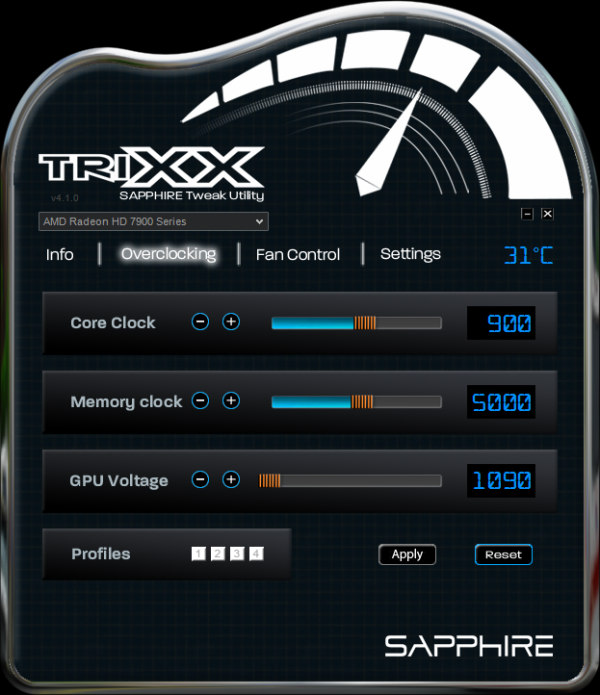AMD Radeon HD 7950 Review Feat. Sapphire & XFX: Sewing Up The High-End Market
by Ryan Smith on January 31, 2012 9:02 AM ESTMeet the Sapphire HD 7950 Overclock Edition
Since our reference 7950s are built on the 7970 PCB and cooler, we’re going to jump right into our vendor cards starting with the Sapphire HD 7950 Overclock Edition.
As with all of the 7950 cards launching today, Sapphire’s HD 7950 Overclock Edition uses the AMD 7950 PCB. This is a slightly shorter PCB measuring 10.25” long, saving .25” over the 7970 PCB by eliminating a few components that the lower board power of the 7950 makes unnecessary. The PCB is otherwise very similar to the 7970 PCB, utilizing 12 GDDR5 memory chips organized around the Tahiti GPU, while at the top you’ll find the 2 CrossFire connectors, a pair of 6pin PCIe power sockets, and the BIOS selection switch. The latter will be of particular interest to unlockers, as the switch should make it possible to safely attempt to unlock the 7950 into a 7970.

Moving on, as this is a semi-custom card the real differentiation is in the factory overclock and the cooler. On the performance side of things Sapphire will be shipping the 7950 Overclock Edition at 900MHz core and 5GHz memory, representing a 100MHz (12.5%) core overclock and no change on the memory clock.
Meanwhile for the cooler Sapphire is using what they’re calling the Dual-X cooler. The Dual-X is yet another double-wide dual-fan open air cooler, with 2 fans providing copious airflow over an aluminum heatsink running virtually the entire length of the card. Sapphire’s fan cutouts are just a bit bigger than most other dual-fan coolers and placed a bit higher, and as a result the Dual-X cooler is a bit taller than the PCB by about 15mm at its highest point. Meanwhile the cooler is also a fair bit longer than the PCB, putting the total card length at 11”.
Moving below the fans and the heatsink we’ll find the heatpipe assembly, which is responsible for carrying heat from the GPU to the heatsink. The Dual-X uses 5 copper heatpipes of varying radius that run from one end of the heatsink to the other. The 5 heatpipes converge at the base of the assembly, where a copper baseplate provides contact with the GPU. Meanwhile cooling for the VRM MOSFETs and RAM is provided by a black aluminum plate, which is placed over those components with heat transfer provided by the use of thermal pads. There is no connection between the plate and the heatsink, so the only heat dissipation from the plate is provided by whatever airflow from the fans reaches the plate.

At the front of the card we’ll find the display ports, which as this is an AMD PCB the card utilizes the standard AMD 7000 series port configuration of 1 DL-DVI port, 1 HDMI port, and 2 mini-DisplayPorts. Filling out the second slot is the grating for ventilation, though even with the ventilation slot the usual precautions for an open-air cooler apply: you’ll need a case with enough airflow to handle the roughly 200W of heat the card is capable of dumping inside of your case.
Rounding out the package is the usual collection of dongles and materials. Sapphire includes 2 molex-to-6pin PCIe adaptors, an HDMI to DVI dongle, a miniDP to DisplayPort dongle, a DVI to VGA dongle, and a 1.8m HDMI cable. Along with the dongles Sapphire packs a quick start guide and a driver installation CD.
The only thing you won’t find packed in the box is TriXX, Sapphire’s in-house overclocking utility. TriXX has been around since the 6900 series, but as this is the first high-end Sapphire card we’ve reviewed since it was released, this is the first time we’ve had it available for a review.
Fundamentally TriXX is a fairly well designed, albeit barebones overclocking utility. Along with an info readout similar to GPU-Z, TriXX provides overclocking and fan control support for Sapphire’s cards, including support for custom fan profiles and more importantly voltage control. With TriXX it’s possible to overvolt most of Sapphire’s performance and high-end cards, and as Sapphire uses AMD reference PCBs it also works with any other cards using AMD’s PCBs.
Beyond these features there’s little more to TriXX. It’s not an all-encompassing video card utility like MSI’s Afterburner, which means it comes up short if you need more functionality but it's exactly what you need if you just want to overclock. To that end it’s a clear step up compared to most other manufacturer’s poorly designed utilities, and from a design perspective its only real sin is the hard to read blue-on-black text. Otherwise it’s a competent overclocking utility that does exactly what it’s supposed to and provides voltage control for those who need it.
Finally, Sapphire will be selling the 7950 OE for $479, $30 over the baseline 7950 MSRP. Meanwhile the warranty on their card is their standard 2 year warranty.















259 Comments
View All Comments
Galidou - Sunday, February 5, 2012 - link
Yeah and then they took out a 8800gt priced so low that they did cut their own leg themselves, lol it was ridiculous, everyone that bought a 8800gts and 8800gtx felt they had been fooled once more by the green goblin :/First time for ATI mispricing their video card higher and look the green goblin fans are all mad...
xeridea - Tuesday, January 31, 2012 - link
Cards always cost more on release as there is built up demand and stock is low. You could have gotten almost as good of performance a year ago... if you don't care about using nearly 100W more power under load, and run 10-25C hotter. There are still 580s selling well over $500 BTW. The Sapphire card has a distinct performance advantage, uses little power, runs 27C under load cooler, near silent, and is cheaper than the average price of the 580.Newegg prices its $20 cheaper than cheapest 580, is faster on average (still fairly new drivers), uses a _LOT_ less power (load and idle), Zerocore power, and a lot cooler all around.. Yeah I would say that is competitive.
Price will surely go down, especially when Nvidia finally gets off its butt and releases its next generation 3 months from now, but it won't make AMD look bad, they will just adjust prices.
OCedHrt - Tuesday, January 31, 2012 - link
AMD is likely charging a premium while it can. Why would it want to significantly undercut NVIDIA pricing which will force NVIDIA to lower their prices as well. It's all about margin, hopefully.Galidou - Sunday, February 5, 2012 - link
Well that's because it's Nvidia's job usually to price their video card higher than they perform, so the green goblin fans are mad because for the first time, AMD fans and rich kidz will buy overpriced video card from the competitor.CeriseCogburn - Sunday, August 26, 2012 - link
LOLamd fanboys are still whining about price, 8 months later, after nVidia drove down their crapship $170 and 3 free games.
Let's face it, amd fanboys are the price whiners. Then after extensive whining, they claim, after the huge 33%+ discounts and free games, that's it's still too high so they will pinch $10 and get the slower amd card, or spend $30 more and get the slower amd card....LOL YES that's what they do.
yankeeDDL - Tuesday, January 31, 2012 - link
Chizow,either you have a very distorted perception of reality, or you're an Nvidia fanboy.
AMD is selling the 7950 at the same price of Nvidia's 580, with the difference that the 7950 has lower power consumption (and noise, and temperature ...) and a plethora of extras.
If you have any clue about what marketing is, you would know that it would be very stupid to lower the price further. They already offer more for the same price: no need to make it any more attractive.
And seriously: do you think that Nvidia, or any other company, in that position, would drop the card prices by $100? Seriously?
If and when Kepler arrives, and if the performance is where it needs to be, then Nvidia will be welcome to lower the prices, and AMD will be forced to follow. It is called competition: that's why it is good to have two (or more) player in a market, not a monopoly.
chizow - Tuesday, January 31, 2012 - link
Again, what don't you understand in my 'distorted view of reality'? I've already laid it out and many others have agreed. What AMD is doing here is unprecedented by pricing their next-gen parts according to last-gen performance.I asked someone else this, but what do you think the reaction would be if Nvidia took 14 months to respond to SI with a "next-gen" part that was only 15-25% faster than the 7970 but cost 10% more, or launched a 7950 equivalent for the same price? There's no progress there....
I mean at that point, even the Nvidia fanboys would declare epic failure don't you think? It makes you wonder why the ATI fanboys don't see it the same way.
As for marketing and competition and all that, you don't seem to get it. At the current prices, AMD makes it very hard for even their own users to justify the cost of these parts. The performance just is NOT there relative to the price when compared to last-gen parts. If they priced these cards more reasonably and similar to their last-gen parts, it would be a no-brainer. But the fact of the matter is, this level of performance was available at this price over a year ago.
yankeeDDL - Wednesday, February 1, 2012 - link
Chizow,what you said the 1st time was clear. No point on repeating it.
You're convinced that AMD should lower the price: frankly, I don't care to explain you why you're wrong. I already said it: the 7950 uses lower power, is less noisy and has more features than the 580, and it offers a (little) higher performance.
ANYONE today buying a 580 would be stupid as they would be getting less for the same price.
So, today, AMD has no reason, whatsoever to lower the price of 7950. AMD is not in business for charity, nor is Nvidia, so if you expect miracles (price-wise) you're in for a surprise.
chizow - Wednesday, February 1, 2012 - link
Right, there's no point in anyone buying a 580 now, just as no one has any reason to buy a 7950 today. If they wanted that level of performance, they could've gotten it any time in the last 14 months for the same price. If they were willing to pay for it, they already have a 580.If they felt the price for that level of performance was too high, they most likely have something in their rig already that fits that price performance metric, and the 7950 does NOTHING to shift their position. There is no incentive for someone who has a 6970 who is getting 85-90% of the 7950's performance to pay 50% more to "upgrade" when they obviously didn't feel that was worth it 14 months ago.
Similarly, do you think it is worth it to "upgrade" to a 7950 if you already own a GTX 580? Of course not! There's simply not enough incentive, and this is why AMD's pricing of this part fails (amongst many other reasons). Does that make sense?
B-Unit1701 - Wednesday, February 1, 2012 - link
What I want to know is where you got this idea that new GPU releases are 'answers' to the other guy's last release? Each new iteration of GPU tech from either side is an improvement or shrink of their own last release putting out more performance. The generation after is already half way thru design phase when the competition unveils their new card, the FASTEST an 'answer' could be developed is 2 generations, and more likely 3.The mistake your making is that assuming that the 580 was the bar AMD was shooting for. It wasnt. They were looking to introduce their new architecture without loosing ground. Looks like nVidias failure with Kepler will enable just that, time to tweak the new design to get the kind of performance numbers you expect to see from a 'next generation' product.